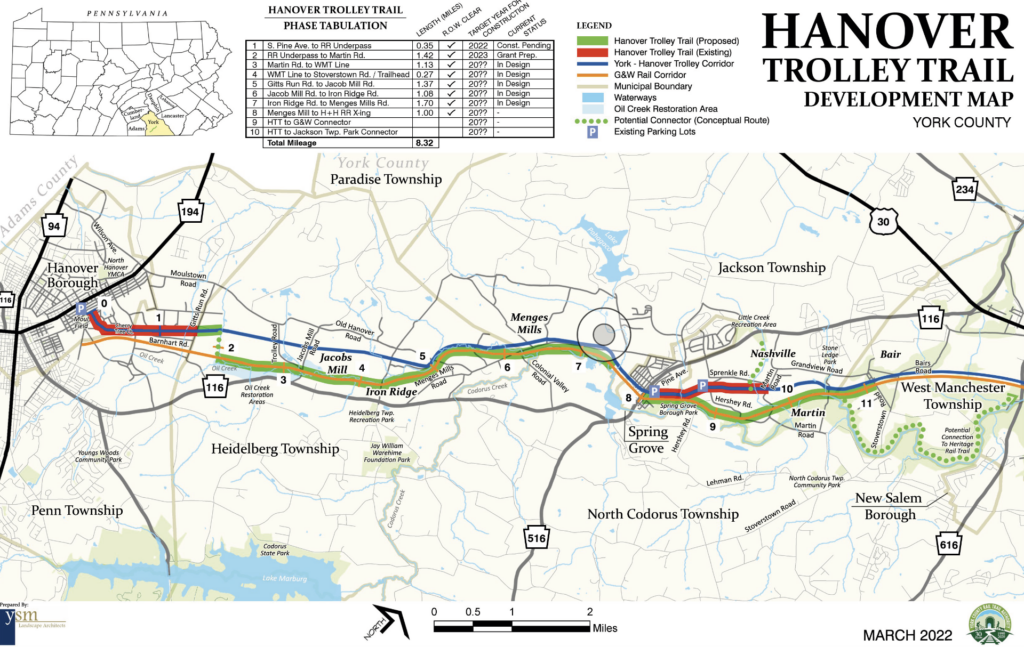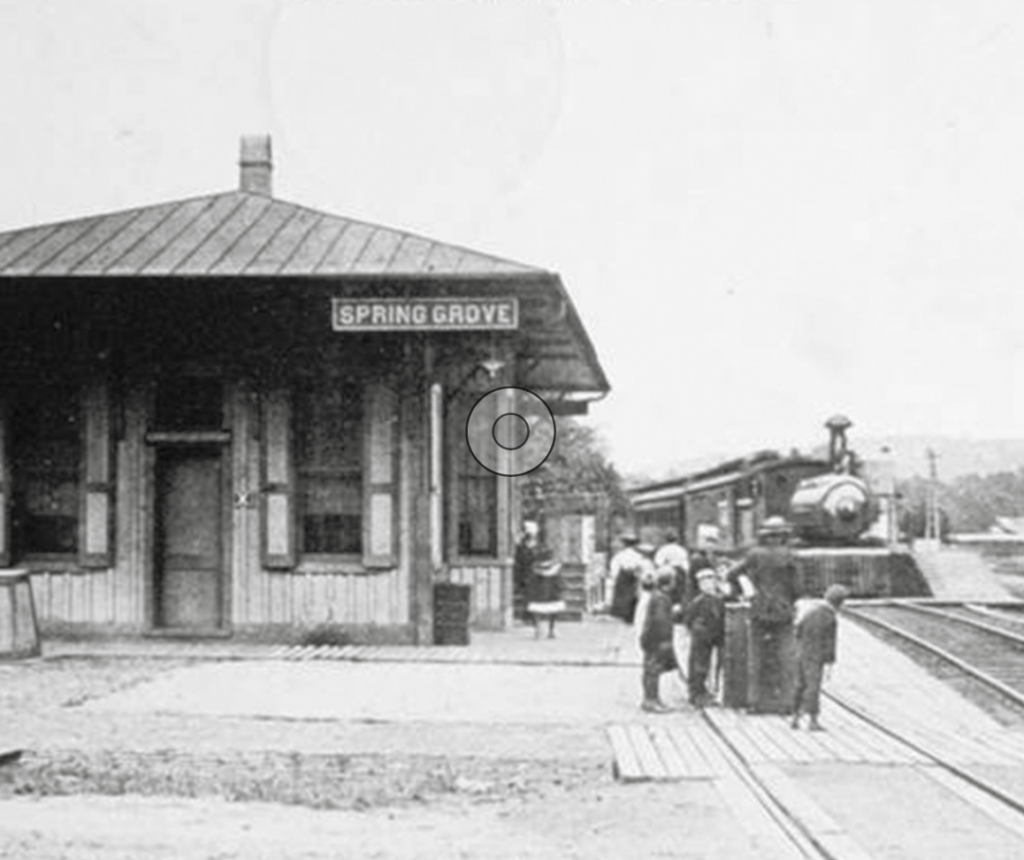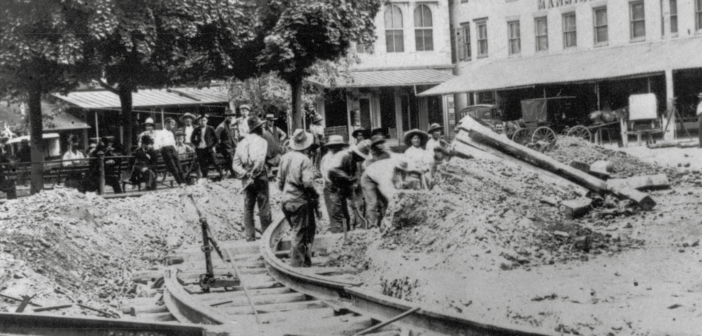Everything old is new again
By Karen Hendricks
While many people are familiar with York County’s 21-mile-long Heritage Rail Trail—one of the first rail trails established in south-central Pennsylvania—it might be surprising to hear that it wasn’t the first project originally envisioned by the community leaders and volunteers who would become known as the York County Rail Trail Authority (YCRTA).
The authority’s original idea, dating back to the 1970s, was to utilize the long-abandoned York Hanover Trolley Line, maintained by electric utility company Met-Ed as a utility corridor, and convert it into a recreational trail. In 1977, YCRTA signed an agreement with Met-Ed that gave the authority licensing rights to construct a trail along the property. It was a pretty revolutionary concept.


“Back in 1977, people didn’t know what a rail trail would be—it was a new idea all across the country,” says Gwen Loose, who has served as YCRTA’s executive director for 25 years.
So what happened to that pie-in-the-sky idea of a trolley trail?
You could say there was a different train of thought. Another opportunity came into the county’s view—the chance to purchase the entire railroad corridor from the Mason-Dixon Line at New Freedom, northward, into the City of York.
“That project took precedence—the Heritage Rail Trail project got built, and the Hanover line was put on the back burner,” says Loose.
And that’s where it remained for more than 20 years. With the completion of the Heritage Rail Trail in 1999, YCRTA revisited and dusted off the trolley trail idea. It made sense for a number of reasons, but primarily because it could serve York County’s second-largest urban area, Hanover. By 2013, two sections of the trail, each two miles, were created—one headed east out of Hanover, and another extending east out of Spring Grove toward York.
Then there were snags, including land use issues with neighboring property owners. And the project once again stalled. Until a wild idea, as Loose calls it, was proposed.
“Local residents know what they have in their own backyard. And we were presented with a wild idea—from one of our municipalities—to buy a dormant railroad which, in many areas, paralleled the Met-Ed corridor,” Loose explains. “People talked about walking along it as a child, saying it was beautiful and ran along the creek.”
Typically, railroads hold onto their properties forever, Loose says.
“But our strategy became, ‘We’ll ask the railroad if we could buy it.’ We really expected that we would get an answer of ‘no,’ but we tried anyway,” Loose recalls.
After a long campaign of phone calls and letter writing, the parent company of the York Railway line, Genesee & Wyoming, based in Jacksonville, Florida, said it would meet with YCRTA. It was December 2017, and there may have been holiday magic in the air.
“It was quite remarkable—the railroad wanted to sell us two sections—Hanover to Spring Grove, and Spring Grove to Bair. It was like Christmas,” Loose remembers.
The purchase—8.5 miles of track for $353,000—was finalized in December 2020. A Pennsylvania Department of Conservation and Natural Resources (DCNR) grant covered about half the cost, and additional grant funders came aboard. A development committee formed. Feasibility studies began.
“Piecing two trails together—that requires a visionary, a person who thinks outside the box. And besides a visionary planting seeds, we’ve been very fortunate to have the York County Economic Alliance feeding us ideas and good solid data on the economic benefits of linking these trails,” Loose says.
Today, 45 years after the initial concept of a Hanover Trolley Trail, the project is now a tale of two rails: the York and Hanover Trolley Line and the York, Hanover, and Frederick Railway.
Backtracking
What do we know about the history of these two lines? Their colorful past may bode well for a creative solution and merger of the two historic lines today.
Construction began on the York and Hanover Trolley Line in 1907. The first 19 miles, operational by 1908, was called the Hanover Fast Line. It was one of five trolley lines radiating from York like spokes on a wheel, according to historical documents researched by Loose and rail historian Ivan Frantz.
“The Hanover Fast Line thrived at first, transporting passengers to work, church, shops, parks, and community events. Three decades after its onset, use began to decline as buses and private automobiles became more popular and highway conditions improved,” write Frantz and Loose in a recently-published YCRTA newsletter.
Trolley service ended in 1939, and the corridor eventually was acquired by Met-Ed.
Meantime, the roots of the York, Hanover and Frederick Railroad Company began with a merger in 1897. And there were many more mergers in its future.
“In 1902, operations were turned over to the Northern Central Railway and classic Pullman cars were put into service,” Frantz and Loose write.
A 1914 merger involved the famous Pennsylvania Railroad.
“For the next thirty-four years, communities along the line from Frederick to York thrived, as did their businesses. However, in 1948 when the railroad lost its mail-hauling contract and passenger service between York and Frederick was terminated, rail service rapidly declined,” they write.
That was the end of the line for the York, Hanover and Frederick Railway. A series of mergers and events followed, and ultimately the line was split up. One section was sold to Ma & Pa Railroad, another was torn out, and the York to Hanover section was sold to York Railway—then acquired by Genesee & Wyoming, who sold it to YCRTA.
On the Right Track
Where does the project stand today? In phases, both of these historic rail lines will blend and merge into the Hanover Trolley Trail.
But first, the project needs to find solid ground—literally.
“In some sections, there were rails with no soil underneath because Oil Creek, during big storm events, was breeching its banks and washing away the soil,” Loose explains. “We had to do some restoration on the stream because we knew nobody would invest in a trail that could wash away.”
Oil Creek, located primarily in Heidelberg Township, feeds into Codorus Creek. Two grants from the Department of Environmental Protection (DEP) launched the restoration. In October, the project received another boost—a $500,000 National Fish and Wildlife Foundation grant. The total restoration cost is about $3 million.
Meantime, a new section of trail, just east of Spring Grove, was paved this past June. A $700,000 DCNR grant will fund another 1.3-mile stretch toward Bair in 2023. It was part of a flurry of recent grant applications—with many hitting paydirt.
But in a twist of fate, YCRTA discovered it was sitting on a gold mine, figuratively speaking.
“Genesee & Wyoming had not been interested in salvaging the rails—they wanted to sell us the York Railway line as-is. We were originally disappointed about this,” Loose explains. “But then the price of metal started to soar, and we realized we were sitting on something, so we began looking at whether anyone wanted to buy the rails.”
They did indeed. YCRTA recently signed an agreement with an Indiana, Pennsylvania, metal salvage company for $403,000—more than YCRTA originally paid Genesee & Wyoming for both the land and rails. It’ll go a long way toward the estimated $8 million needed to complete the 8.5-mile trail connecting Hanover with Spring Grove into Bair—which Loose predicts will take about five years.
As the project gains traction, anticipation is building in Hanover.
“Outdoor recreation is a huge revenue generator, both for businesses and the communities themselves,” says Justine Trucksess, Main Street Hanover’s executive director. “And on an interpersonal level, people want outdoor opportunities to enjoy exercise, to enjoy time with their families.”
Currently, a Hanover Action Team with the York County Trail Towns program is identifying a route for what’s being called the Hanover Trolley Trail’s downtown connector. It would link the trail’s current end, by Moul Field, to the downtown. Trucksess says Guthrie Memorial Library has been earmarked as one of the best potential downtown trailheads as a community hub offering parking.
Hundreds of volunteers have contributed to the YCRTA’s successful track record over the decades, and this project is no exception.
“The rail trail authority has always been a group of volunteers, with assistance from one staff person,” says Loose—who currently is that staff person. “I have to continue to applaud the people who have served as volunteers; they’re the key to our success.”
But there’s one more wild idea to consider: Will the Hanover Trolley Trail ever connect Bair to York, linking to the Heritage Rail Trail?
“That will take another visionary,” Loose says. “Someday it will happen, but I don’t know that I will be sitting here doing the work.”
Trucksess sees the beauty in the concept.
“The fact that we could use that same line to again connect Hanover to greater York County is kind of cyclical,” says Trucksess, “like history repeating itself.”
For more information on the Hanover Trolley Trail and York County Rail Trail Authority, visit yorkcountytrails.org.




